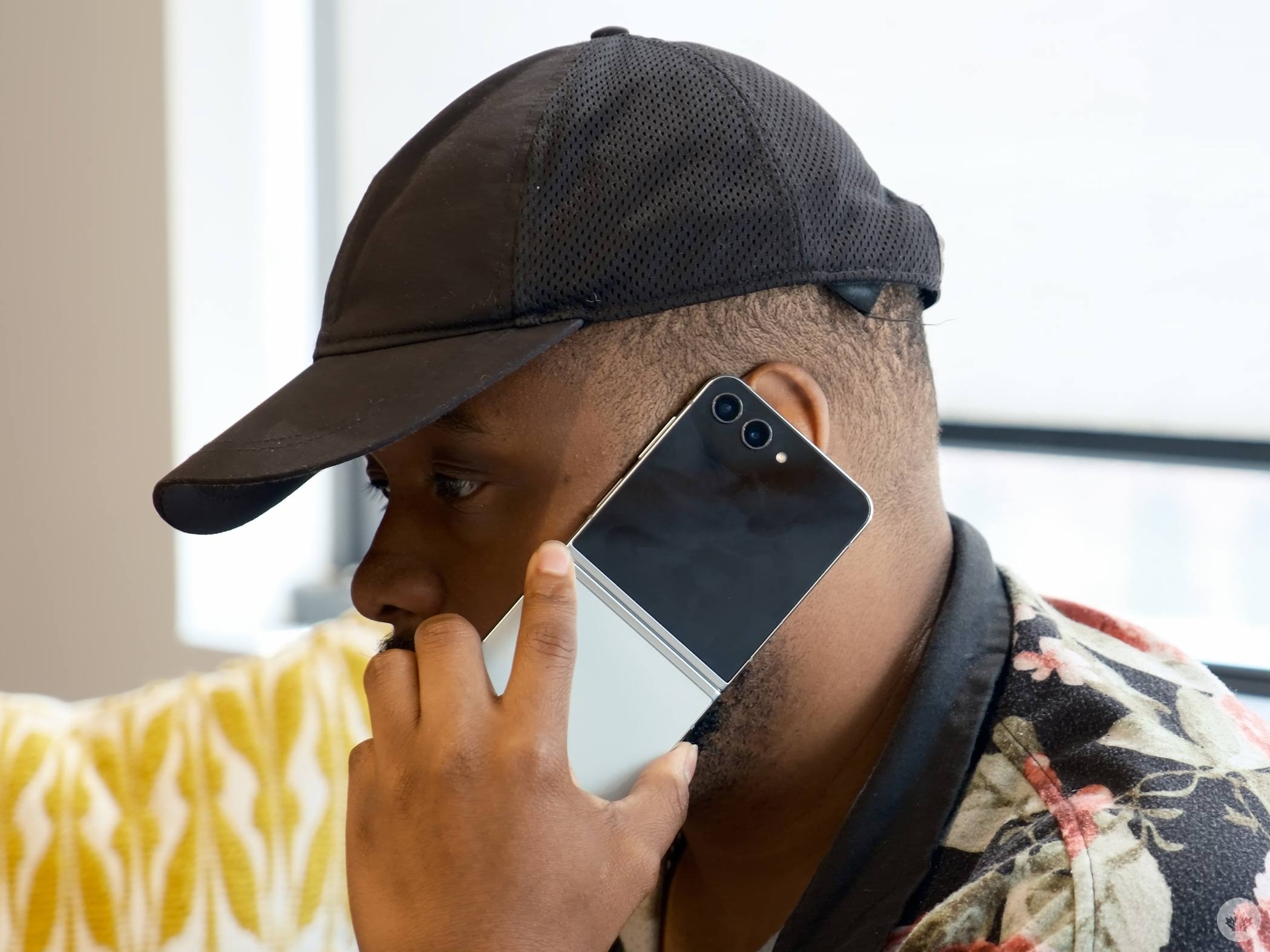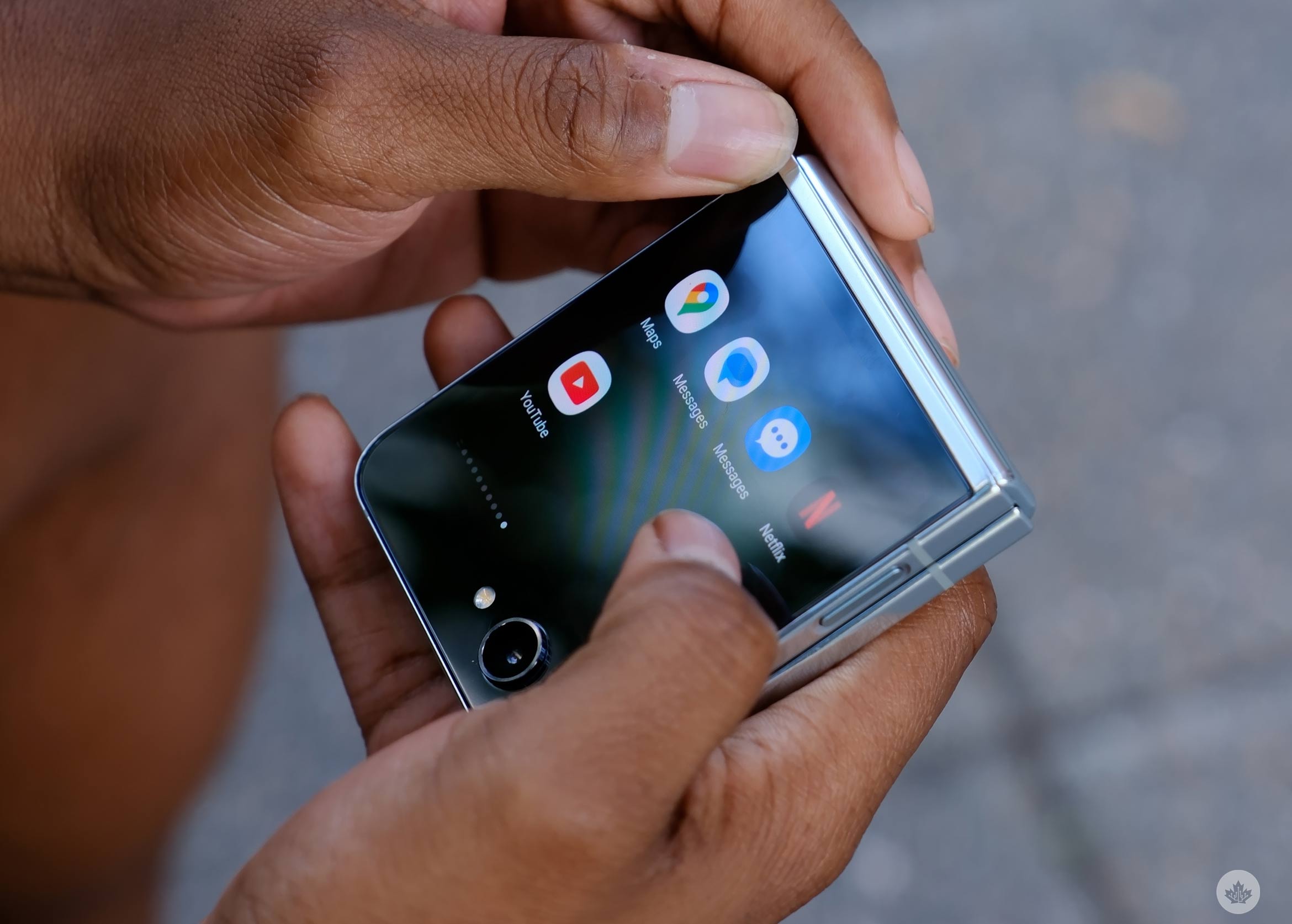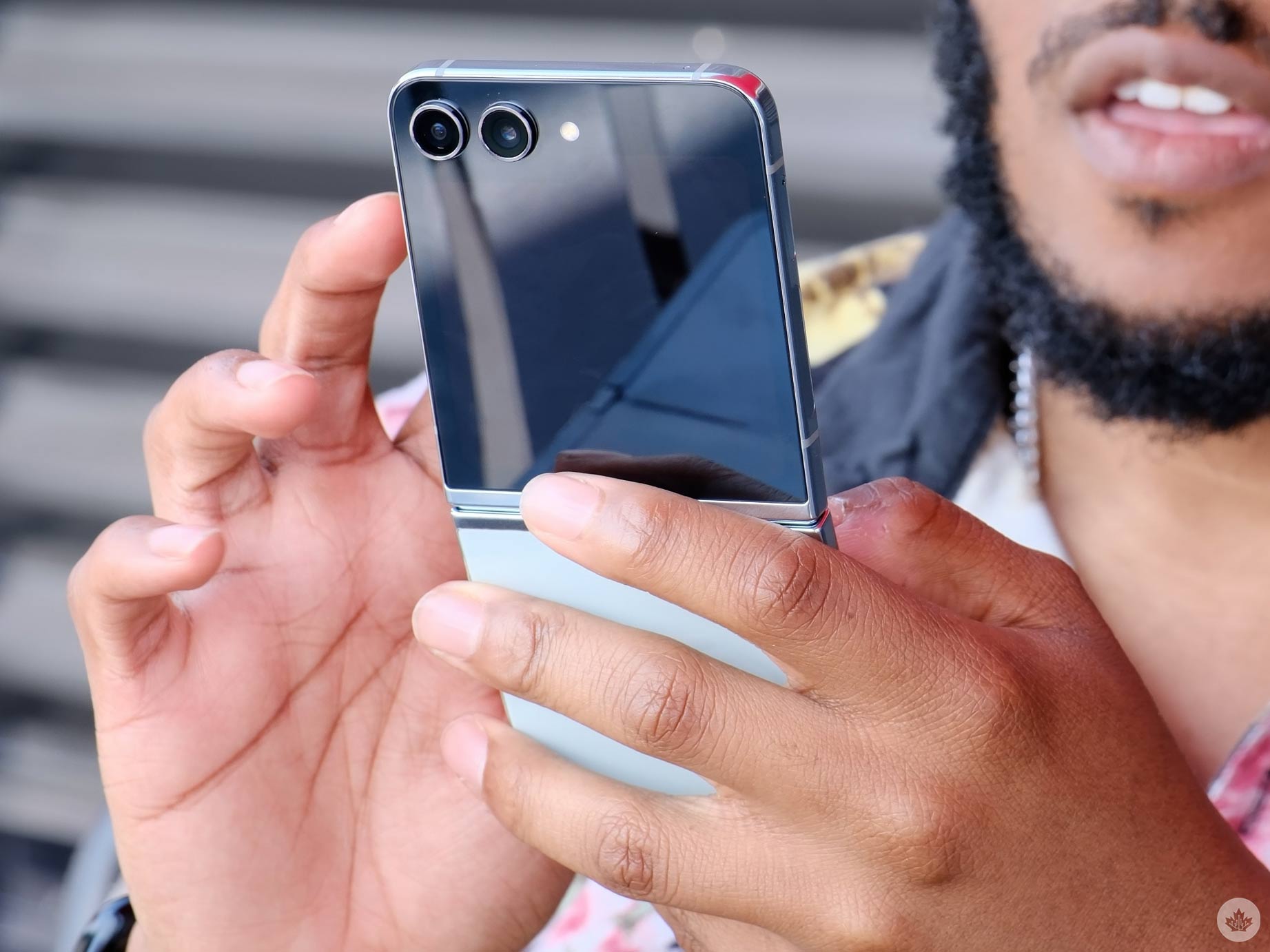the Galaxy Z Flip 5, Samsung’s latest clamshell foldable, comes with an added bonus if you compare it to the tech giant’s past Z Flip devices.
This year, the South Korean tech giant has added a 3.4-inch Cover Screen to the front of the device, which is far better than last year’s 1.9-inch display. While great in isolation, the Z Flip 5 has real competition this year for the first time in Canada.
When it comes to reviewing smartphones, it’s always best to look at what the competition offers so that you can accurately gauge the device you’re covering. After all, no tech products — especially smartphones — exist in a vacuum. For instance, if two phones offer the same features, but one costs $500 less than the other, it’s worth docking points from the more expensive of the two.
For years, Samsung has operated in a world where its foldables dominate the North American market because there isn’t any real competition. However, with the rise of Motorola’s and Google’s foldable devices, the company finally has a battle for the throne.
In Canada, where the Motorola Razr+ and the Z Flip 5 are both priced at $1,299, those interested in a clamshell foldable now have a new question: should you buy the Razr+ or the Galaxy Z Flip 5? Let’s get into it.
Main Screen: 6.7-inch FHD+ 120Hz display, Dynamic AMOLED 2X, Infinity Flex Display (2640 x 1080) | Cover Screen: 3.4-inch Super AMOLED Display (720 x 748)
Main Screen: 6.7-inch FHD+ 120Hz display, Dynamic AMOLED 2X, Infinity Flex Display (2640 x 1080) | Cover Screen: 1.9-inch Super AMOLED Display (260 x 512)
Main Screen: 6.9-inch FHD+ 165Hz display, (2640 x 1080) HDR10+ | Cover Screen: 3.6-inch pOLED Display (1066 x 1056)aa
128GB, 256GB and 512GB of storage
Folded: 71.9 x 85.1 x 15.1mm | Unfolded: 71.9 x 165.1 x 6.9mm
Unfolded: 165.2 x 71.9 x 6.9mm | Folded: 84.9 x 71.9 x 17.1mm (Hinge) – 15.9mm (Sagging)
Open: 73.95 x 170.83 x 6.99mm | Closed: 73.95 x 88.42 x 15.1mm
188.5g (Infinite Black, Glacier Blue) | 184.5g (Viva Magenta)
12 MP, f/1.8, 27mm (wide), 12 MP, f/2.2, 123˚ (ultrawide)
12 MP, f/1.8, 27mm (wide), 12 MP, f/2.2, 123˚ (ultrawide)
12-megapixel (f/1.5, OIS) + 12-megapixel (f/2.2, OIS, ultra-wide)
10 MP, f/2.4, 26mm (wide)
10 MP, f/2.4, 26mm (wide)
Fingerprint (side-mounted), accelerometor, gyro, proximity, compass
Capacitive Fingerprint sensor (side), Accelerometer, Barometer, Gyro sensor, Geomagnetic sensor, Hall sensor, Proximity sensor, Light sensor
Fingerprint (side-mounted), accelerometor, gyro, proximity, compass
Bora Purple, Graphite, Pink Gold, Blue and Bespoke customizations
Infinite Black, Glacier Blue, Viva Magenta
Main Screen: 6.7-inch FHD+ 120Hz display, Dynamic AMOLED 2X, Infinity Flex Display (2640 x 1080) | Cover Screen: 3.4-inch Super AMOLED Display (720 x 748)
Main Screen: 6.7-inch FHD+ 120Hz display, Dynamic AMOLED 2X, Infinity Flex Display (2640 x 1080) | Cover Screen: 1.9-inch Super AMOLED Display (260 x 512)
Main Screen: 6.9-inch FHD+ 165Hz display, (2640 x 1080) HDR10+ | Cover Screen: 3.6-inch pOLED Display (1066 x 1056)aa
128GB, 256GB and 512GB of storage
Folded: 71.9 x 85.1 x 15.1mm | Unfolded: 71.9 x 165.1 x 6.9mm
Unfolded: 165.2 x 71.9 x 6.9mm | Folded: 84.9 x 71.9 x 17.1mm (Hinge) – 15.9mm (Sagging)
Open: 73.95 x 170.83 x 6.99mm | Closed: 73.95 x 88.42 x 15.1mm
188.5g (Infinite Black, Glacier Blue) | 184.5g (Viva Magenta)
12 MP, f/1.8, 27mm (wide), 12 MP, f/2.2, 123˚ (ultrawide)
12 MP, f/1.8, 27mm (wide), 12 MP, f/2.2, 123˚ (ultrawide)
12-megapixel (f/1.5, OIS) + 12-megapixel (f/2.2, OIS, ultra-wide)
10 MP, f/2.4, 26mm (wide)
10 MP, f/2.4, 26mm (wide)
Fingerprint (side-mounted), accelerometor, gyro, proximity, compass
Capacitive Fingerprint sensor (side), Accelerometer, Barometer, Gyro sensor, Geomagnetic sensor, Hall sensor, Proximity sensor, Light sensor
Fingerprint (side-mounted), accelerometor, gyro, proximity, compass
Bora Purple, Graphite, Pink Gold, Blue and Bespoke customizations
Infinite Black, Glacier Blue, Viva Magenta
That bigger Cover Screen
The handset’s front display, or ‘Cover Screen’ as Samsung calls it, offers a 3.4-inch panel featuring a 720 x 748-pixel resolution and a 60Hz refresh rate. The screen looks great, and there’s a cut-out for the dual camera setup. But for direct comparison, the Razr+ features a 3.6-inch display with a 1056 x 1066-pixel resolution and a 144Hz refresh rate. On paper, Motorola wins the display specs battle.
The Razr+’s front display lacks a cut-out for the cameras, and you can choose to have what you’re looking at wrap around the two cameras, a welcome touch that’s, unfortunately, not that useful. It’s pretty good for watching content, though. Samsung’s Flip 5 lacks this ability, but that alone doesn’t make the Razr+’s front screen better than Samsung’s offering.
It’s more about what you can do with each of the front displays. Both allow you to have multiple tiles (or pages) that, for the most part, you can fill with widgets. Samsung offers a cool feature that allows the first tile (or homepage) to be a video wallpaper, giving it an added layer of customization that I really like. This lets you swipe to the left for notifications and to the right for other widgets.
These widgets include the weather, calendar, recent calls, favourite contacts, alarms, stopwatches, timers, Samsung Health, a step counter, and a stock widget. You can even set up Samsung Wallet. Plus, you can access the handset’s cameras if you double-tap your power button. You can also add five apps to the Cover Screen: Google Messages, Samsung Messages, Netflix, YouTube and Google Maps. If you’re listening to music, it continues to the front screen, and you can toggle your quick settings. This is great, and if I’d never used Motorola’s take on the feature, I’d love it. However, Razr+’s panels can show the home page, Google News, contacts, weather, calendar, Motorola’s games, Spotify and Google Fit. Further, the front display can use any app you’ve downloaded on your phone.

On the other hand, Samsung’s widgets are colourful and look a lot nicer than what Motorola offers. Samsung also allows you to set a video as your wallpaper, which is very cool, but looks aren’t everything. The Z Flip 5’s front screen is too limited, and not allowing you to access every app on your device is a misstep.
If I see a notification for WhatsApp, Instagram or Facebook Messenger, and I want to reply, I should be able to reply from the Cover Screen, but I can’t because the display doesn’t have the option. If I hear a song I don’t know and want to pull up Shazam quickly, I can’t do that. If I want to utilize the full Spotify app on the front screen to change a playlist or album, again, that’s also not possible. And if you’re like me and would rather use Google Pay instead of Samsung Pay on the front of your device, you can’t.
“There’s a satisfying ‘snap’ feeling when it fully opens up, and you can tell that Samsung learned from last year’s Flip 4.”
It’s worth noting there is a way to fix this issue that just requires you to install two apps from Samsung: Good Lock and Multistar, which is available within Good Lock. You’ll only be able to find Good Lock in the Samsung Store, but downloading it allows you to add any app you want to the Cover Screen, including even Google Pay. However, it’s frustrating Samsung doesn’t allow you to do this by default. But once that’s done, the Cover Screen on Samsung’s foldable is more comparable and arguably better than the Razr+’s front display.
Samsung’s Cover Screen looks great despite featuring a lower screen resolution and a slower refresh rate compared to Motorola’s foldable. It can still do a lot, and it’s a significant improvement over last year’s smaller display; however, in its current state, it’s too limited. I’m quite easy to please, and I think if Samsung allowed any app to be used on the front screen, I’d view the Z Flip 5 as the clear winner here. Hopefully, Samsung will add this feature in a future update, but until then, I prefer the Razr+’s front display.
Premium foldable design
Samsung’s Z Flip 5 weighs in at 165.1 x 71.9 x 6.9mm unfolded and 85.1 x 71.9 x 15.1mm folded, making the handset more compact than the Razr+. I find this size difference especially noticeable when the phone is folded. The front of the Razr+ is longer as it hosts a large top bezel, whereas the Z Flip 5’s is a bit bigger on the sides. The two devices are almost the same weight, except the Razr+ is heavier depending on the model you purchase. For example, Razr+’s Viva Magenta version offers vegan leather, making it lighter than the Infinite Black model.
Regarding the hinge, the Galaxy Z Flip 5’s feels more well-built, durable and reliable than the Razr+. There’s a satisfying ‘snap’ feeling when it fully opens up, and you can tell that Samsung learned from last year’s Flip 4.

The Z Flip 5 features more squared-off edges, similar to an iPhone and Samsung S series handsets, which feel sturdy and even premium. But flat edges don’t fit as nicely in your hand as the Razr+ curved option.
When opened, the Z Flip 5 sports a 6.7-inch 1080 x 2640 pixel resolution as well as HDR10+ and a 120Hz refresh rate. During my time with the phone, I always ran the Z Flip 5’s display with adaptive 120Hz turned on. This can scale down the device’s refresh rate to 11Hz when doing something static, like texting or reading, or push it to 120Hz while scrolling or gaming, similar to many other Samsung devices like the Z Fold 5 and the S23 Ultra.
The viewing experience on the device is great, and watching YouTube and Netflix videos on the Z Flip 5 is pleasant. The foldable’s screen doesn’t offer the highest resolution, but it’s good enough for most people. It’s worth mentioning that the Galaxy Z Flip 5 features a longer display, and when you fully expand videos on YouTube, the stretched crop looks very odd.

Samsung’s Z Flip 5 still has a pretty obvious crease, and it hasn’t gotten any better than what was available on the Z Flip 4. But as always, you can easily ignore this and eventually get used to it. However, if you are entirely against the crease, check out the Razr+ because it’s much less visible in comparison.
On the front, the Z Flip 5 features an ‘Infinity-O’ selfie shooter placed in the top centre of the device, along with bezels running around the premium feeling display.
Flipping the phone to the rear, there’s the aforementioned glossy Gorilla Glass Victus 2 and a screen at the top that’s black when opened and Mint on the bottom, giving the Flip 5 a dual-tone design. There are also two 12-megapixel cameras and a dual-LED flash, and the smartphone features a volume rocker and a power button that doubles as a fingerprint scanner on the right side.
The Z Flip 5 also comes in ‘Cream,’ ‘Lavender,’ ‘Gray,’ ‘Blue,’ ‘Green,’ and ‘Yellow,’ but the last three colours are exclusive to Samsung.
Good flippin’ cameras
The Z Flip 5 features two 12-megapixel cameras: one primary wide-angle lens and another ultrawide angle lens with a 123-degree angle.

The cameras take great pictures, and as always, Samsung has a heavy Scene Optimizer that oversaturates pictures, but these photographs still look pretty good. I took some pictures while out kayaking, and the colours of the sky, trees, and the kayak itself all popped up. That said, there is a bit of surrealism as the world itself isn’t as beautiful as the pictures depict. While turning off Scene Optimizer helps, images still aren’t as true to life as Apple’s iPhone 14 Pro handles photos.
Compared to the S23 Ultra and the Z Fold 5, there’s less detail and no telephoto camera, but the device’s shooters are still good.
Of course, the Z Flip 5 has the Cover Screen, which acts as a viewfinder to take selfies, portrait mode photos or videos. I love foldables’ ability to take selfie pictures with their primary cameras, meaning your selfie game is better than people who use a regular selfie shooter, and I love taking selfies. You can also fold your phone to have it sit up like a tripod, and if you’re video recording, you can hold it like a camcorder; both of these methods can help with the already-good video stabilization.
If you’re someone who’s interested in this handset versus the Razr+ and you really like taking pictures, then it’s probably best you pick the Z Flip 5.
Nitty Gritty
Samsung’s Galaxy Z Flip 5 sports a Qualcomm Snapdragon Gen 2 processor, 8GB of RAM, and up to 512GB of storage. The handset also comes with Android 13, One UI 5.1.1 and a 3,700mAh battery.
Everything runs smoothly, but if you have several apps open at once, I noticed there’s a slight lag when closing and opening the device. Thankfully, clearing apps helps this. This only happened when I had a game, the camera app and YouTube open simultaneously, and I was opening and closing the phone a lot as I tested out the device. I haven’t noticed any lag with regular usage.
Benchmark-wise, we’re looking at the second-highest I’ve ever seen from an Android device, with a single-core score of 2,030 and a multi-core score of 5,233. This even beats the Galaxy S23 Ultra, which is quite impressive. Of course, this is slightly worse than the single-core score of 2,066 and the multi-core score of 5,549 from the Z Fold 5.

In terms of battery, the Z Flip 5 can easily survive a full day on its charge. I’ve experienced situations where I’m running out of battery when shooting a lot of videos or pictures where it’s not at zero by the end of the day but below 20 percent. However, using a video wallpaper for my Cover Screen also contributes to this. On the other hand, I found that the Razr+ features a slightly more reliable battery, but the difference isn’t substantial.
Using the Sound Meter app, I determined the Z Flip 5’s speakers typically peaked around 75 to 79 decibels. This is pretty loud, but the sound profile doesn’t offer a lot of bass.
